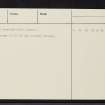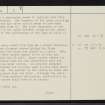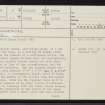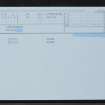Pricing Change
New pricing for orders of material from this site will come into place shortly. Charges for supply of digital images, digitisation on demand, prints and licensing will be altered.
Upcoming Maintenance
Please be advised that this website will undergo scheduled maintenance on the following dates:
Thursday, 9 January: 11:00 AM - 3:00 PM
Thursday, 23 January: 11:00 AM - 3:00 PM
Thursday, 30 January: 11:00 AM - 3:00 PM
During these times, some functionality such as image purchasing may be temporarily unavailable. We apologise for any inconvenience this may cause.
Linsidemore
Cairn (Prehistoric)
Site Name Linsidemore
Classification Cairn (Prehistoric)
Alternative Name(s) A837; Invershin; Rosehall
Canmore ID 13038
Site Number NH59NW 5
NGR NH 5436 9901
Datum OSGB36 - NGR
Permalink http://canmore.org.uk/site/13038
- Council Highland
- Parish Creich (Sutherland)
- Former Region Highland
- Former District Sutherland
- Former County Sutherland
NH59NW 5 5436 9901.
(NH 5436 9901) Cairn Circle (NR)
OS 1:10,000map, (1970)
A natural gravel mound, encircling which, at a few feet above its base, is a setting of stones which seems to be the remains of a continuous circle, the stones of which appear to have been set contiguously. Two or three pointed stones remain set with their broad faces in line of the circumference, but the majority are boulders. The two largest stones remaining in situ measure 3'10" x 2'10" and 3' x 2'10" respectively. A quadrangular block, about 2' high, placed in the centre of the circle, does not appear to be in situ. From the NE, running round by E to SW, are the remains of an outer circle of boulders which seem to converge with the inner circle towards the NE. The elevation of the centre of the inner circle suggests that a small cairn may have existed there, while a depression seems to indicate that this has been excavated. The diameter of the inner circle is from 40'-43' and the outer circle seems to have been some 6' distant from it. The exact character of the construction is not quite evident, owing to the interference due to the cultivation of the land in which it stands.
RCAHMS 1911, visited 1909.
A mutilated cairn about 2.0m high on a slight elevation which has been ploughed around giving the false impression that the cairn was placed on a knoll. Only four or five kerb stones appear to be in situ and these are round the NE half. About twelve others lie displaced outside them and are undoubtedly what the RCAHMS called an outer circle. An accurate diameter cannot be obtained but it would seem to have been about 13.5m to 14.0m. The boulder in the centre is loose and probably displaced from the kerb. Although the cairn has suffered from sporadic mutilation, particularly in the SW, the centre would seem to be intact.
Surveyed at 1:2500 (visited by OS [EGC] 12 June 1963).
Visited by OS (J M) 17 September 1974.
No change to previous field report.
Revised at 1:10,000 and 1:2500.
Visited by OS (J M) 27 October 1976.
An archaeological excavation was carried out at this site in 1995 ahead of road improvement works. The road was to be straightened at a blind bend, which threatened an area immediately adjacent to the kerbed burial cairn. An area was investigated between the cairn and the existing road, where activity associated witht the use of the cairn monument might be expected. A number of features were found, including a series of burnt layers in a pit, and two dark, linear features containing quantities of small stone. The linear features were deemed to be drainage ditches. No other features were recorded and it was noted that the area had been severely affected by ploughing.
R Gourlay 1995
Field Visit (5 October 1909)
Stone Circle (supposed), Linsidemore.
At Linsidemore, on a croft near the middle of the township, and some 40 yards N. of the high road, is a natural gravel mound, encircling which, at a few feet above its base, is a setting of stones, which seems to be the remains of a continuous circle, the stones of which appear to have been set contiguously. Two or three pointed stones remain set with their broad faces in line of the circumference, but the majority are boulders. The two largest stones remaining in situ measure 3' 10" x 2' 10" and 3' x 2' 10" respectively. A quadrangular block, about 2' high, placed in the centre of the circle, does not appear to be in situ. From the NE., running round by E. to S\V., are the remains of an outer circle of boulders which seem to converge with the inner circle towards the NE. The elevation of the centre of the inner circle suggests that a small cairn may have existed there, while a depression seems to indicate that this has been excavated. The diameter of the inner circle is from 40' to 43', and the outer circle seems to have been some 6' distant from it. The exact character of the construction is not quite evident, owing to interference due to the cultivation of the land in which it stands.
OS 6-inch map: Sutherland Sheet cii. (unnoted).
RCAHMS 1911, visited (AOC) 5th October 1909.














